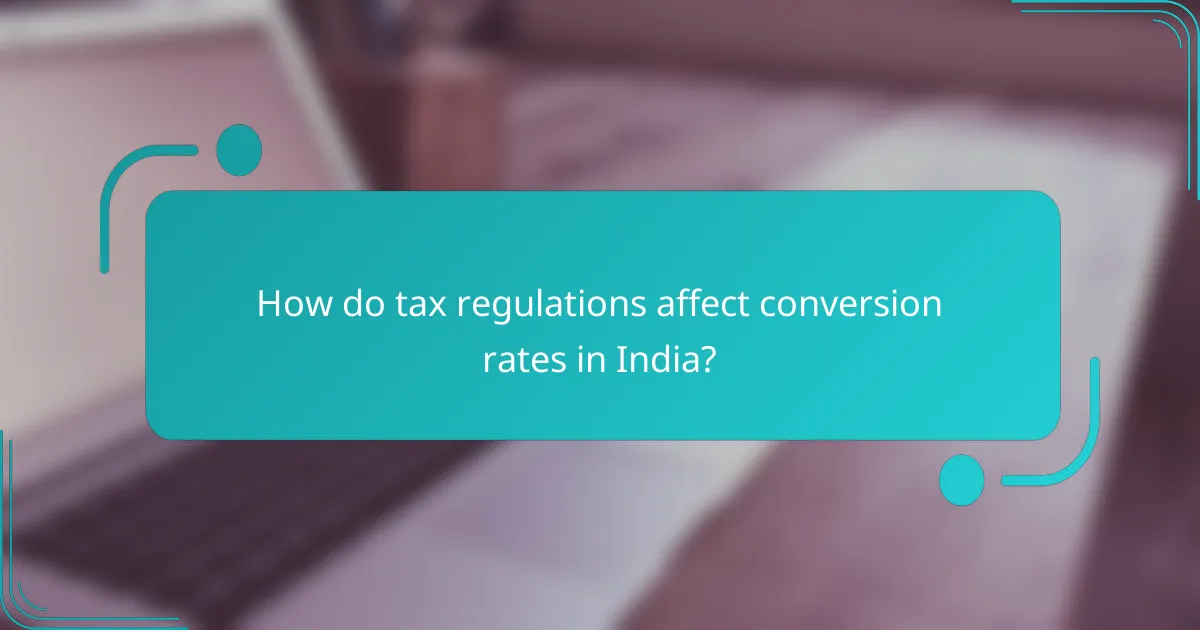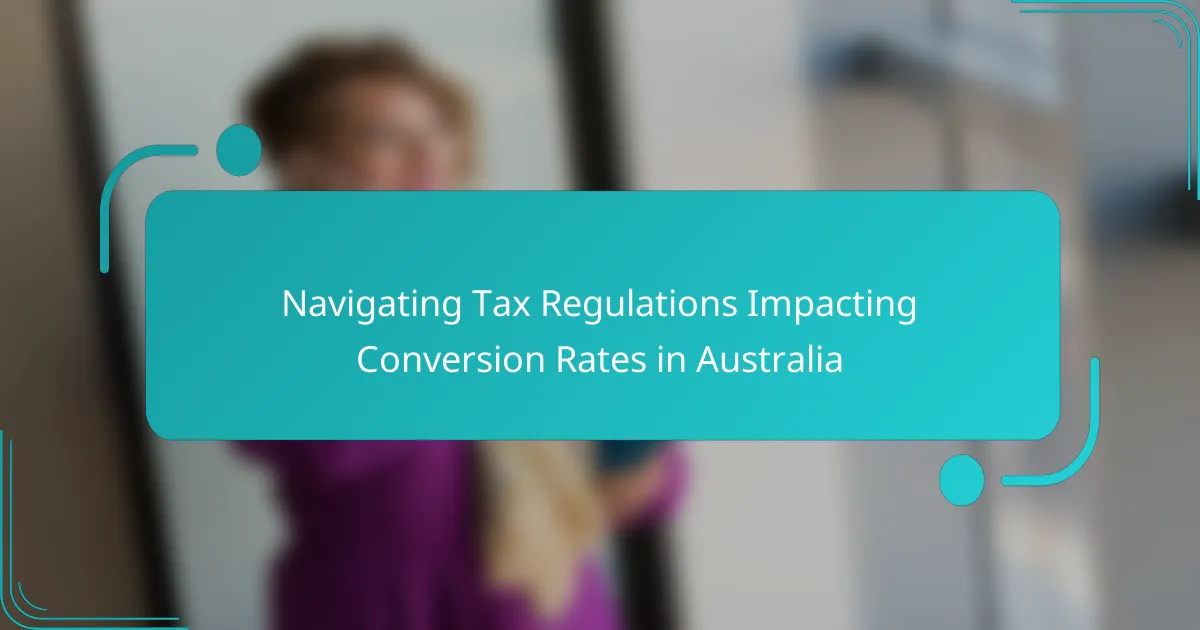Tax regulations in India play a crucial role in shaping conversion rates by affecting pricing strategies, customer behaviour, and overall marketing efforts. Key regulations such as the Goods and Services Tax (GST) and the Income Tax Act necessitate a thorough understanding for businesses aiming to enhance their financial performance and compliance. By optimising pricing and leveraging tax incentives, companies can improve customer trust and drive sales amidst the complexities of the tax landscape.

How do tax regulations affect conversion rates in India?
Tax regulations significantly influence conversion rates in India by impacting pricing, customer behaviour, and marketing strategies. Understanding these effects can help businesses optimise their operations and improve sales performance.
Impact on pricing strategies
Tax regulations dictate how much businesses can charge for their products or services, directly affecting pricing strategies. For instance, the Goods and Services Tax (GST) in India can alter the final price consumers pay, which may lead to adjustments in pricing to maintain competitiveness.
Businesses often need to consider the tax burden when setting prices. If taxes increase, companies might absorb the costs or pass them on to consumers, which can influence conversion rates. A common approach is to keep prices attractive while ensuring compliance with tax laws.
Influence on customer purchasing behaviour
Tax regulations can shape customer purchasing behaviour by affecting their perceived value of products. Higher taxes may lead consumers to delay purchases or seek alternatives, impacting overall conversion rates. For example, if a product’s price rises due to increased taxation, customers may opt for cheaper substitutes.
Promotions or discounts that offset tax increases can encourage purchases. Businesses should analyse customer responses to tax changes and adjust their marketing strategies accordingly to maintain engagement and conversion rates.
Effects on marketing budgets
Tax regulations can also influence marketing budgets, as businesses must allocate funds to comply with tax obligations. Increased operational costs due to taxes may lead to reduced marketing expenditures, which can negatively impact conversion rates.
Companies should prioritise effective marketing strategies that maximise return on investment. For instance, focusing on digital marketing channels can be more cost-effective, allowing businesses to reach a larger audience without overspending on traditional advertising due to tax constraints.

What are the key tax regulations in India?
The key tax regulations in India that impact conversion rates include the Goods and Services Tax (GST), the Income Tax Act, and the Tax Deducted at Source (TDS). Understanding these regulations is crucial for businesses to optimise their financial performance and ensure compliance.
Goods and Services Tax (GST)
The Goods and Services Tax (GST) is a comprehensive indirect tax levied on the supply of goods and services in India. It replaced multiple indirect taxes and aims to streamline the tax structure, making it easier for businesses to comply.
Businesses must register for GST if their turnover exceeds a specified threshold, which is generally around INR 20 lakhs for most states. GST rates vary depending on the type of goods or services, typically ranging from 5% to 28%. Accurate invoicing and timely filing of returns are essential to avoid penalties.
Income Tax Act
The Income Tax Act governs the taxation of income earned by individuals and businesses in India. Companies are taxed at a standard rate, which can vary based on their turnover and type of business, generally between 25% and 30% for domestic companies.
Filing income tax returns is mandatory for all businesses, and maintaining proper financial records is crucial for compliance. Deductions and exemptions can significantly affect taxable income, so understanding these provisions can help optimise tax liabilities.
Tax Deducted at Source (TDS)
Tax Deducted at Source (TDS) is a mechanism where tax is deducted at the source of income. This applies to various payments, including salaries, interest, and contract payments, ensuring that tax is collected at the point of payment.
Businesses must comply with TDS regulations by deducting the appropriate percentage of tax before making payments. The TDS rates vary based on the nature of the payment, and timely deposit of the deducted amount is crucial to avoid penalties. Regularly reviewing TDS obligations can help maintain compliance and avoid cash flow issues.

What strategies can improve conversion rates under tax regulations?
Improving conversion rates in India while navigating tax regulations involves optimising pricing strategies, leveraging available tax incentives, and implementing transparent pricing models. These approaches can enhance customer trust and drive sales despite the complexities of compliance.
Optimising pricing for GST compliance
To optimise pricing for GST compliance, businesses must ensure that their prices reflect the Goods and Services Tax (GST) accurately. This means incorporating the correct GST rates into the final price displayed to customers, which can range from 5% to 28% depending on the product or service category.
Consider offering inclusive pricing where the GST is already factored into the displayed price. This transparency can help customers understand the total cost upfront, potentially increasing conversion rates as they are less likely to abandon their carts due to unexpected charges at checkout.
Leveraging tax incentives for marketing
Utilising tax incentives can enhance marketing efforts and improve conversion rates. The Indian government offers various schemes that provide tax benefits for specific sectors, such as startups or businesses in certain regions. By highlighting these incentives in marketing campaigns, businesses can attract more customers who are looking for value.
For instance, if a business qualifies for a tax holiday or reduced GST rates, promoting these advantages can create a competitive edge. Ensure that marketing materials clearly communicate these benefits to encourage potential customers to make a purchase.
Implementing transparent pricing models
Transparent pricing models build customer trust and can lead to higher conversion rates. Clearly displaying the breakdown of costs, including base price, GST, and any additional fees, helps customers understand what they are paying for. This clarity can reduce cart abandonment rates.
Consider using a pricing table that outlines all costs associated with a purchase. This approach not only informs customers but also positions the business as honest and straightforward, which can significantly enhance customer loyalty and encourage repeat purchases.

How can businesses adapt to changing tax laws in India?
Businesses in India can adapt to changing tax laws by implementing regular compliance practices, staying informed about reforms, and consulting with tax professionals. These strategies help ensure that companies remain compliant and can effectively manage their tax liabilities, ultimately supporting better conversion rates.
Regular compliance audits
Conducting regular compliance audits is essential for businesses to identify and rectify any discrepancies in their tax filings. These audits should be performed at least annually and can help uncover areas where tax obligations may have changed or where errors may have occurred.
Businesses should create a checklist for their audits, including reviewing tax returns, verifying deductions, and ensuring all necessary documentation is in place. This proactive approach minimises the risk of penalties and enhances overall financial health.
Staying updated with tax reforms
Staying updated with tax reforms is crucial for businesses to navigate the evolving tax landscape in India. This can be achieved by subscribing to tax newsletters, attending workshops, or following updates from the Central Board of Direct Taxes (CBDT).
Understanding recent changes, such as modifications to the Goods and Services Tax (GST) or corporate tax rates, allows businesses to adjust their pricing strategies and maintain competitive conversion rates. Regularly reviewing these updates can prevent costly mistakes and ensure compliance.
Engaging tax consultants
Engaging tax consultants can provide businesses with expert guidance on navigating complex tax regulations. These professionals can offer tailored advice based on the specific needs of the business, ensuring compliance and optimising tax strategies.
When selecting a tax consultant, consider their experience with Indian tax laws and their track record with similar businesses. This partnership can lead to significant savings and improved financial decision-making, ultimately enhancing conversion rates.

What are the prerequisites for effective tax strategy implementation?
Effective tax strategy implementation requires a clear understanding of local regulations, target market segments, and a solid financial framework. These elements ensure that businesses can navigate tax obligations while optimising conversion rates in India.
Understanding local tax obligations
To effectively manage tax strategies in India, businesses must first comprehend their local tax obligations. This includes understanding Goods and Services Tax (GST), income tax, and any applicable state-level taxes that may affect pricing and profitability.
Regularly reviewing changes in tax legislation is crucial, as regulations can evolve. Engaging with a tax consultant can help clarify complex rules and ensure compliance, minimising the risk of penalties.
Identifying target market segments
Identifying target market segments is essential for tailoring tax strategies that align with consumer behaviour. Businesses should analyse demographics, purchasing patterns, and regional preferences to optimise their offerings and marketing efforts.
For instance, targeting urban consumers may require different pricing strategies compared to rural markets, considering varying tax implications and consumer spending power. Segmenting the market can lead to more effective tax planning and improved conversion rates.
Establishing a robust financial framework
A robust financial framework supports effective tax strategy implementation by ensuring accurate tracking and reporting of financial data. This includes maintaining detailed records of sales, expenses, and tax payments to facilitate compliance and strategic planning.
Utilising accounting software can streamline this process, allowing businesses to generate reports that reflect their tax obligations and financial health. Regular audits can also help identify discrepancies and areas for improvement, ensuring that the financial framework remains strong and adaptable.

What are the emerging trends in tax regulations affecting e-commerce in India?
Emerging trends in tax regulations are significantly impacting e-commerce in India, particularly through increased scrutiny and adaptation to digital business models. These changes are reshaping how online businesses operate, influencing pricing strategies and compliance requirements.
Increased focus on digital taxation
The Indian government is placing greater emphasis on digital taxation, aiming to ensure that e-commerce companies contribute fairly to the economy. This includes the introduction of the Equalisation Levy, which targets foreign digital service providers, requiring them to pay taxes on revenue generated from Indian consumers.
Businesses must be aware of the implications of this levy, as it can add to operational costs. Companies should consider adjusting their pricing models to accommodate these taxes while remaining competitive in the market.
Changes in cross-border tax implications
Cross-border tax regulations are evolving, affecting how e-commerce companies manage international transactions. New guidelines may require businesses to navigate complex tax obligations when selling to customers in different countries, including compliance with local tax laws.
To mitigate risks, companies should consult with tax professionals to understand their obligations in both India and the countries they operate in. This proactive approach can help avoid penalties and ensure smooth cross-border operations.
